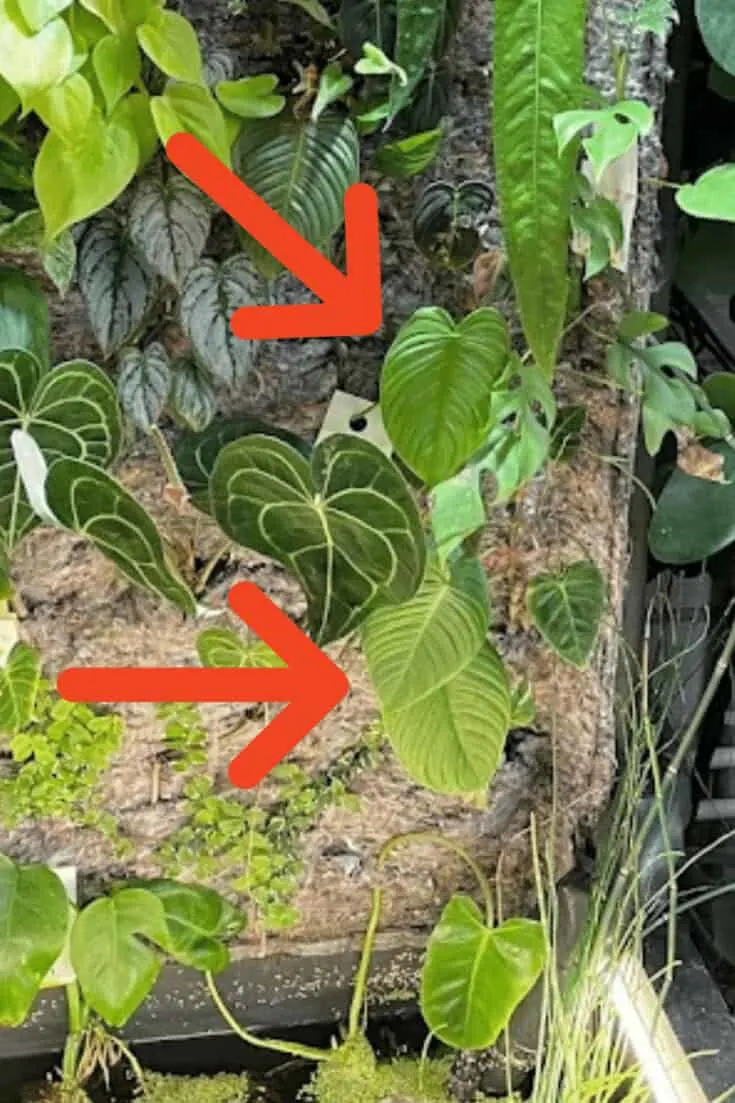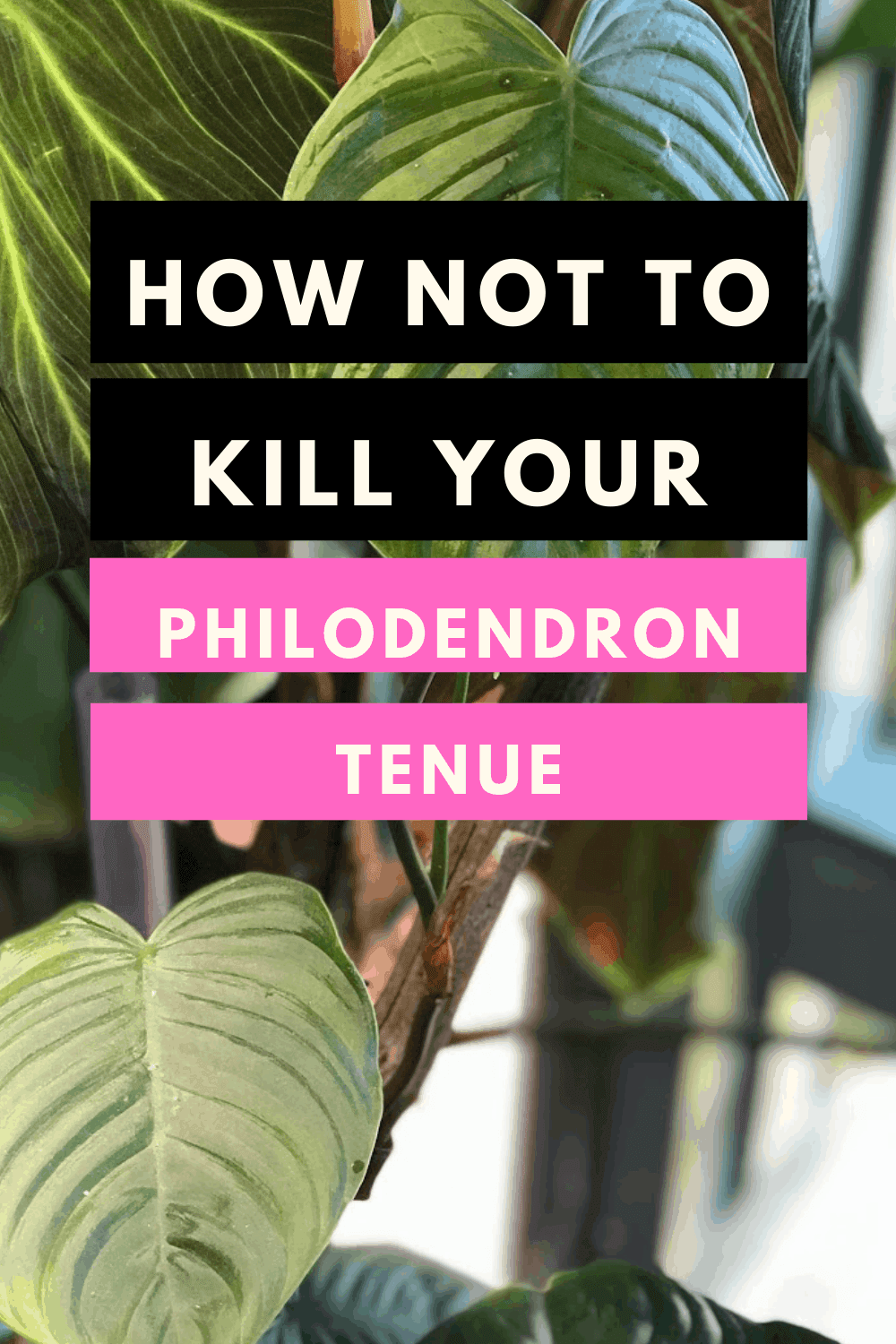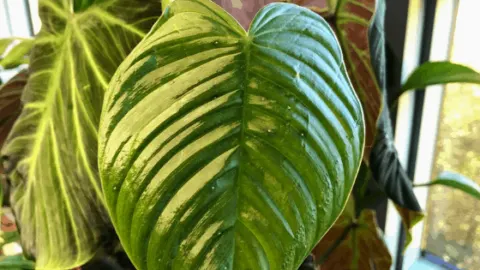In today’s article, I’m going to discuss Philodendron Tenue care.
The Tenue is a Hemi-epiphytic plant known for being a climber and was initially described in 1854.
The plant is also known by several other names such as Philodendron Ecuadorense and Philodendron Sodiroanum.
Philodendron Tenue Care
Philodendron Tenue is a rainforest plant and therefore enjoys a good amount of watering. This Philodendron does not enjoy cold temperatures but loves high humidity close to 90%. Maintain a temperature of 64 to 90 degrees Fahrenheit (18 to 32 degrees Celsius). Fertilize once a week in spring and summer using Osmocote or Nutricote.

Philodendron tenue loves very high humidity of 90% or higher
Table of Contents
Philodendron Tenue
This houseplant belongs to the Philodendron genus and is part of the Araceae family according to Earth.com.
The Tenue is found in various forms. Two of the most common types either have narrow leaves or normal broad leaves.
The leaves have a beautiful lush green color and rippled texture.
The plant is native to the Nicaragua and Pacific slope of Venezuela.
It is also found in Central America at various elevations.
Apart from being a beautiful natural decoration, the plant is known for its air-purifying properties.
This is especially true of the wider leafed Tenue variety.
Philodendron Tenue Plant Care Guide
Soil
A Philodendron Tenue needs to be grown in evenly damp soil. This allows the plant’s roots to continue drawing fresh oxygen.
In most cases, when this is not taken care of, root rotting may start to occur.
I have noticed many people going for rich soil as they are too lazy to water their Philodendron Tenue.
This is not a wise choice because you are depriving your plant of oxygen as it is not receiving enough water.
A typical potting soil does not work well with the Tenue.
I prefer to grow my Philodendron in loose soil, which is a fast-draining and contains ingredients such peat, perlite.
An aroid also often charcoal and gravel. This mixture helps to maintain the soil pH between 5-8, which is considered ideal for a Philodendron Tenue.
Water
Your Tenue plant needs to be watered regularly in the growing season, whereas sparingly in winter.
The Philodendron species root structure is designed to collect water in the rainiest seasons.
Even in dry weather conditions, the plant can get water from its surroundings by focusing its energy on absorbing humidity close to its roots.
Tropical plants like the Philodendron Tenue need just as much water in winter. Dew and fog are important supplements during the winter season.
However, our house interior does not have either of them. So if you don’t water your plant during the winter, you are basically killing it.
I recommend using soil that holds moisture well with good drainage.
I prefer using a soil mixture containing 30% soil, 20% peat, 10% perlite, and the rest shredded leaves – just like a typical rainforest soil.
Adding charcoal might not seem like a good choice, but in my personal experience, it helps by increasing drainage.
Light
As previously mentioned, the Philodendron Tenue is native to rainforests in South American regions where light is a precious commodity.
Most plants fight for the right amount of light, which is why most Philodendrons are climbers.
As these plants need to grow towards light by climbing against something, I prefer to grow mine near a tall totem.
I recommend using a wet wall.
This type of wall is covered with wirings filled with moss and sphagnum.
Since most rainforests are dark, it is natural to assume that direct light is not the way with your Philodendron Tenue.
Do not place it in low light either
The trick is to place it in such a position where the light is bright, but it is receiving it indirectly.
For example, I place mine behind a sheer curtain to mellow the light.
Temperature
Philodendron Tenue is a tropical plant, which tells you that these plants do not enjoy cold temperatures for a long period.
That is why I highly recommend not placing your PhilodendronTenue in a room, which is often blasted with air conditioners.
Typical temperatures for a Philodendron Tenue should not fall below 55 degrees Fahrenheit (12.75 degrees Celsius).
It is further recommended that you grow your Philodendron in temperatures below 90 degrees Fahrenheit (32.22 degree Celsius), which is achievable if you grow them in shaded or filtered light.
An optimal temperature range for Philodendron Tenue is 64 to 90 degrees Fahrenheit (18 to 32 degrees Celsius).
Humidity
Humidity is extremely important for your Philodendron Tenue. The humidity level in most jungles is close to 100%.
If you live in parts with low humidity, an alternative method is recommended, like a humidifier.
I recommend using some water-loving plants to add the surrounding moisture.
DIY – Pebble Tray
You may also try making a simple one using a DIY technique to maintain the humidity for your Philodendron Tenue.
One can do this by making a homemade pebble tray.
- Place a good amount of water inside a deep tray or plate.
- Gently place the pot on the pebbles without touching the water directly.
A pebble-tray is a good and simple home remedy that will maintain the moisture around the plant as the water evaporates.
Fertilizer
Philodendron Tenue in their natural habitat, survive by feasting on dead vegetation, which decays around the roots.
However, we often end up making the mistake of cleaning out the dead and decaying matter.
As much as your intentions might be in the right place, this isn’t a good thing for a Philodendron. By cleaning the decaying matter, you are depriving it of natural fertilizer.
If natural fertilizer is hard to find, I recommend using diluted fertilizer.
A good rule of thumb is to fertilize it once a week in spring and summer.
If you have a good agriculture supplier near your place, take advantage and buy pellet forms of Osmocote or Nutricote.
These are pellet fertilizers, which last up to four months.
Repotting
Philodendron Tenue has a good root structure. That is why you should not let your Tenue become root-bound.
Otherwise, its growth can start to slow down.
Most Philodendrons grow slowly.
So repotting might be needed after two to three years. In case your Tenue decides to have a growth spurt, you need to repot it.
I recommend repotting your PhilodendronTenue during the spring and summer seasons as those are considered their growing seasons.
Following are the steps I follow to report my Tenue:
- I remove the Philodendron Tenue from its old pot without damaging its root or stems.
- Next, I carefully plant the Tenue into a bigger pot.
After the last step, I keep watering and fertilizing my plant as usual.
Your Philodendron will be saved from getting suffocated, thereby promoting good growth.
Pruning
Since Philodendron Tenue is a climber, they tend to grow fast and take the support of random things to grow over them.
If you decide to prune your Tenue, make sure the equipment is sanitized. This will prevent any transfer of infections or germs.
I highly recommend not pruning too much, or else you can stunt the growth of your Tenue.
Keep your plant dust-free to give it a neater look. By keeping your plant clean, you are stimulating its healthy growth.
Propagation
The Philodendron Tenue can be propagated by two methods; stem cutting and air layering.
Stem Cutting
The steps for stem cutting are not hard to follow. You only require an appropriate size of the stem with a rhizome
A leaf will speed up the process but is not necessary.
Secondly, you must have the right potting mix.
- As a first step, I sterilize my knife and cut the stem up to seven to eight inches long. I make sure there is a leaf node that is intact with the cut stem.
- I make sure to keep less than three leaves.
- Then I propagate my Tenue in a potting mix containing the right ratio of ingredients.
- To propagate the Philodendron Tenue’s stem, I place it in water. Then I place it in a warm and humid area to observe root formations.
- For soil propagation, I clip the ends of the stem of the Tenue to dip it in a rooting hormone. Then, I place the plant stem in wet soil while keeping a close eye on how tall the plant is standing by itself.
- Next, I place the plant at the part of the house, which has ample light but not direct exposure.
- To make sure my Tenue is growing roots. I gently tug at it to feel any resistance.
- Lastly, I remain patient and wait for the plant to start showing some progress in the two to three weeks that follow.
Air Layering
Air layering encourages the growth of new Philodendron Tenue without being removed from the parent plant.
- For this technique, pinpoint at least two nodes on the Tenue. The nodes are the bumpy parts on the stems.
- After making your choice, wrap the stem with moist moss using a thread or a cling film.
- While root formation takes time, I recommend continuously misting the moss.
- Once tiny roots are formed, you can take the stem cutting.
Blooms
The Philodendron Tenue is known for producing at least four inflorescences per axil. These measure up to 0.7 inches to 4.3 inches.
The inflorescences are green or white in color, but sometimes you can notice a heavy tinge of red.
The spathe is known for being thick. The fruit berries are, however, purple in color.
The flowers on the Tenue appear during the dry season and early parts of the rainy season.
The months with heavy inflorescences are April and May.
Growth
The Philodendron Tenue is a climber whose leaves grow close to the parent tree.
The petioles supporting the leaf blades can grow between 11 and 42 inches in length (29 centimeters to 107 centimeters).
A mature plant can develop leaves that are 3 ft long.

Philodendron Tenue Care
Common Problems for Philodendron Tenue
Aphids
Aphids are insects with soft bodies that suck the nutrients by biting into the areas of the plant which have the most nutrients.
In large numbers, they weaken the plant considerably by spreading over the weak parts.
If not taken care of from the beginning, they grow fast, which makes it difficult to control them.
Several problems can follow an aphid infestation. The leaves of your Philodendron Tenue can lose them, thereby curling them.
Sometimes they even lose their color, becoming yellow. Aphids enjoy living in the underside of the Tenue’s leaves.
Every time they feed on the part of a Tenue, they leave behind honeydew, which promotes sooty mold.
Certain aphids even cause the formation of galls on the roots and leaves of Philodendron Tenue.
They are also notorious for spreading viruses from an infected plant to a healthy plant.
Controlling Aphids is not that difficult. That’s because these insects move rather slowly. Simply spraying cold water helps to dislodge them from the leaves.
Natural methods like dusting the leaves with flour suffocated the insects.
Even natural insecticides like Neem oil are effective for household plants like Philodendron Tenue.
Mealybugs
Mealybugs appear on Philodendron Tenue as tiny pests with soft bodies.
The small fringes on their body keep them attached to the stem and leaves of Philodendron Tenue.
They damage the Tenue by sucking out the sap juices from the stem, especially when they are in the growing stage.
Over time, the leaves of the Tenue wrinkle and die from yellowing, as the mealybugs feed on important nutrients like magnesium, which help to give the plant its green color.
Mealybugs too leave behind honeydew after feeding in a spot. This causes fungal growth leading to other problems like mite and fungal infections.
Mealybugs can be kept away if your Philodendron Tenue is maintained well by proper pruning, water, and dusting.
You should keep your Tenue away from any stress by placing it away from direct light, small potting, and less moisture.
Mealybugs can be removed by using a water hose to jet these bugs away.
Insecticidal soaps such as ivory liquid can also be sprayed on mealybugs.
Plant Stress
Apart from pests and insects, sometimes we humans over care for our plants.
And sometimes we just don’t do enough for them. This can cause Tenue’s to stress out
Wilting is a stress response to not receiving enough water.
When your soil is too loose for the Philodendron Tenue, it will not retain enough moisture resulting in the plant drying up too fast.
Being a tropical plant, you should keep your plant moist as deep as possible.
Bleaching is another form of a stress response.
When Philodendron Tenue’s are exposed to direct sunlight, they can get burned.
To prevent bleaching from taking place, keep the Tenue away from direct light.
Philodendron Tenue’s are tropical plants that do not do well in extremely cold conditions.
If you notice blackened leaves or parts of the stem, your Tenue has frostbite.
Normally witnessed in winters or sometimes when placed in a room with blasting air conditioners.
Nothing to worry about, though, as good care often results in the plant outgrowing the damage.
Your Philodendron can also have dried leaf margins.
This is an indication that you have over-fertilized your plant.
That is why I highly recommend artificial fertilizer users to read the label and follow the instructions given carefully.
Thrips
Thrips are household pests that damage plants in a manner close to mealybugs as they feed on juices from the stem.
The damage causes the Tenue’s leaves to turn pale and silvery.
I manage thrips by keeping the garden well-maintained. This reduces the areas where they breed, such as in the crop debris.
Tips for Growing Philodendron Tenue
Following are important pointers that I tell my followers regarding Philodendron care:
- During the dormant stage, do not fertilize your plant too much as it is their resting phase.
- Avoid touching your face or eyes after touching a Philodendron Tenue, as the plant’s sap contains Calcium Oxalate, which causes a nasty sting.
- No leaf should be placed inside the soil at the time of propagation.
- Try using natural fertilizers as artificial fertilizer upon overuse can cause the soil pH to get disturbed.
Frequently Asked Questions About Philodendron Tenue Care
When do the roots start growing after propagation?
The roots of Philodendron Tenue appear by the third week. It is at this time you should start preparing for repotting as the plant will outgrow its old pot. Lastly, do not forget to fertilize as per routine.
Will my Tenue be fully grown after three weeks of propagation?
Philodendron Tenye fully grows after the third week. In some cases, the growth can be hampered due to environmental stressors like inadequate moisture or light.
Which soil is considered the best for Philodendron Tenue?
Philodendron Tenue grows best in natural soil. Therefore, if you have decaying dead leaves, do not throw them away. Use them as fertilizer instead.
Does Philodendron Tenue have a long life?
Philodendron Tenues are climbers. Climbers are known for their instinct to survive. They grow towards the stimulus, which provides the most benefit. That’s why these plants can grow by themselves quite well.
What other pests can infect my Philodendron Tenue?
Sometimes cobweb formation can be observed on your Philodendron Tenue. Therefore, don’t forget to dust your plant as a dusty space is an ideal spot for them to thrive.
Conclusion
Philodendron Tenue should be your first choice if you are growing an indoor plant for the first time.
Not only is it easy to grow, but its climber properties and beautiful inflorescence also make it a wonderful decoration on walls and hanging baskets.
Philodendron Tenue is a must-have plant if you wish to decorate your house with natural greenery.
The scientific data about this plant indicates it can tolerate a wide variety of environments, which makes it a perfect houseplant.


